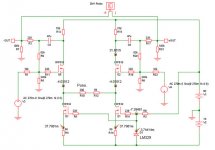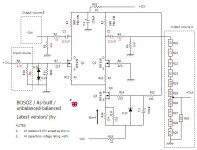Henrik said:Hi Magura
The only benefit from two CCS' is the possibility to adjust gain on the fly using just one resistor/attenuator between the sources of the diffpair, just like in Passlabs Aleph P preamps.
http://www.passlabs.com/downloads/old product/apserv17.pdf
Best regards Henrik
Hmm, that would be a nice detail to include.
Would it work with 100R-2K(pot)-100R like in the Aleph P circuit?
Magura🙂
Magura said:
Hmm, that would be a nice detail to include.
Would it work with 100R-2K(pot)-100R like in the Aleph P circuit?
Magura🙂
I agree with Henrik, otherwise the 2 CCS are in parallel sharing the load and some interaction may occur.
Doing it a la Aleph P seems sensible to me but have never compared so is just an opinion.
Henrik said:Magura
It could look something like this.
Regards.
Thanks Henrik.
Why is it you always run the CCS on lower voltage in your BOSOZ's? To me it seems just as good to run +-60V, is that right?
Why have you chosen so low values for the resistors between the differential pair (compared to the values used in Aleph P) ??
Magura 🙂
Magura said:
...math?
No math. All of my math is 1+1 > or = 1.
I think that all caps have varying Xc at varying frequency. If the cap is part of resistor cmplex, it could be part of resistor attenuator. I attach my BOSOZ as an example. If I use output cap with 10uF for my latest circuit, I would not get flat output gain in the range of audio frequencies. The curve of gain values vs. frequencies is not flat (the lower frequency, the higher gain), making the balance of music unbalnaced. This happens the same at any volume level. Therefore, I use 220uF to compensate it.
I presume you know the math very well.
Regards
jH
Attachments
Magura said:
Thanks Henrik.
Why is it you always run the CCS on lower voltage in your BOSOZ's? To me it seems just as good to run +-60V, is that right?
Why have you chosen so low values for the resistors between the differential pair (compared to the values used in Aleph P) ??
Magura 🙂
The lower voltage at the negative rail is simply becauce you don't need nore than a few volts across the CCS fet, but 60 V works as well, more heat though.
The lower values of the source resistors is caused by the feedback which reduces the gain, so to get it up again you lower the values of the resistors. But do some experiments in real life to find the proper values. I think that a Potm. at 1-2K is fine.
BTW I think that an inputresistor at 1K and an feedback resistor at 47K will give you almost none X or at least verry little. IMO you need something in the range of 10K at the input with an feedback resistor at 47K.
Outputcaps at 50 uF inside the X feedback loop will give you a -3db cut off at 120KHz ore more with a 100 Ohm load, so normally you should be more than safe with 10uF.
Henrik said:The source resistors at 68 Ohm must be shorted.
Other wise it looks ok to me.🙂
You mean the 6R8 resistors, right?
...and why?
Cheers
Magura🙂
The 2K pot and the 56 Ohm resistor now connects the sources of the diffpair fets an controls the gain, they so to speak replaces the two 68 Ohm resistors in Kristian K version. If you don't short them your gain will be too low
Cheers
Henrik

Cheers
Henrik
Magura
To get space for the gain adjustment, your feedback resistor should be around 82K to 100K, like the scematic i posted earlier.
Regards
To get space for the gain adjustment, your feedback resistor should be around 82K to 100K, like the scematic i posted earlier.
Regards
Gain in X Pre-Amp
Hi folks,
In one of my incarnations of my X-BOSOZ , I used a stepped switch to vary the gain by varying the amount of feedback. From a sonic point of view this was not the best solution. With more feedback/less gain the sound became veiled. Finally, I opted for input and output attenuation and 10dB of gain. Just like Nelson recommends
Hope this helps,
Fox
Hi folks,
In one of my incarnations of my X-BOSOZ , I used a stepped switch to vary the gain by varying the amount of feedback. From a sonic point of view this was not the best solution. With more feedback/less gain the sound became veiled. Finally, I opted for input and output attenuation and 10dB of gain. Just like Nelson recommends

Hope this helps,
Fox
Re: Gain in X Pre-Amp
That's what I'm planning to do as well. If you take a look at one of the first posts in this thread, you will find a link to the attenuator I'm going to use on the output (balanced ladder configuration). I plan to use a fixed input resistor and match my sources instead of changing the input resistor.
Magura🙂
Fox said:Hi folks,
Finally, I opted for input and output attenuation and 10dB of gain. Just like Nelson recommends
Hope this helps,
Fox
That's what I'm planning to do as well. If you take a look at one of the first posts in this thread, you will find a link to the attenuator I'm going to use on the output (balanced ladder configuration). I plan to use a fixed input resistor and match my sources instead of changing the input resistor.
Magura🙂
- Status
- Not open for further replies.
- Home
- Amplifiers
- Pass Labs
- The ultimate CCS-X-BOSOZ


